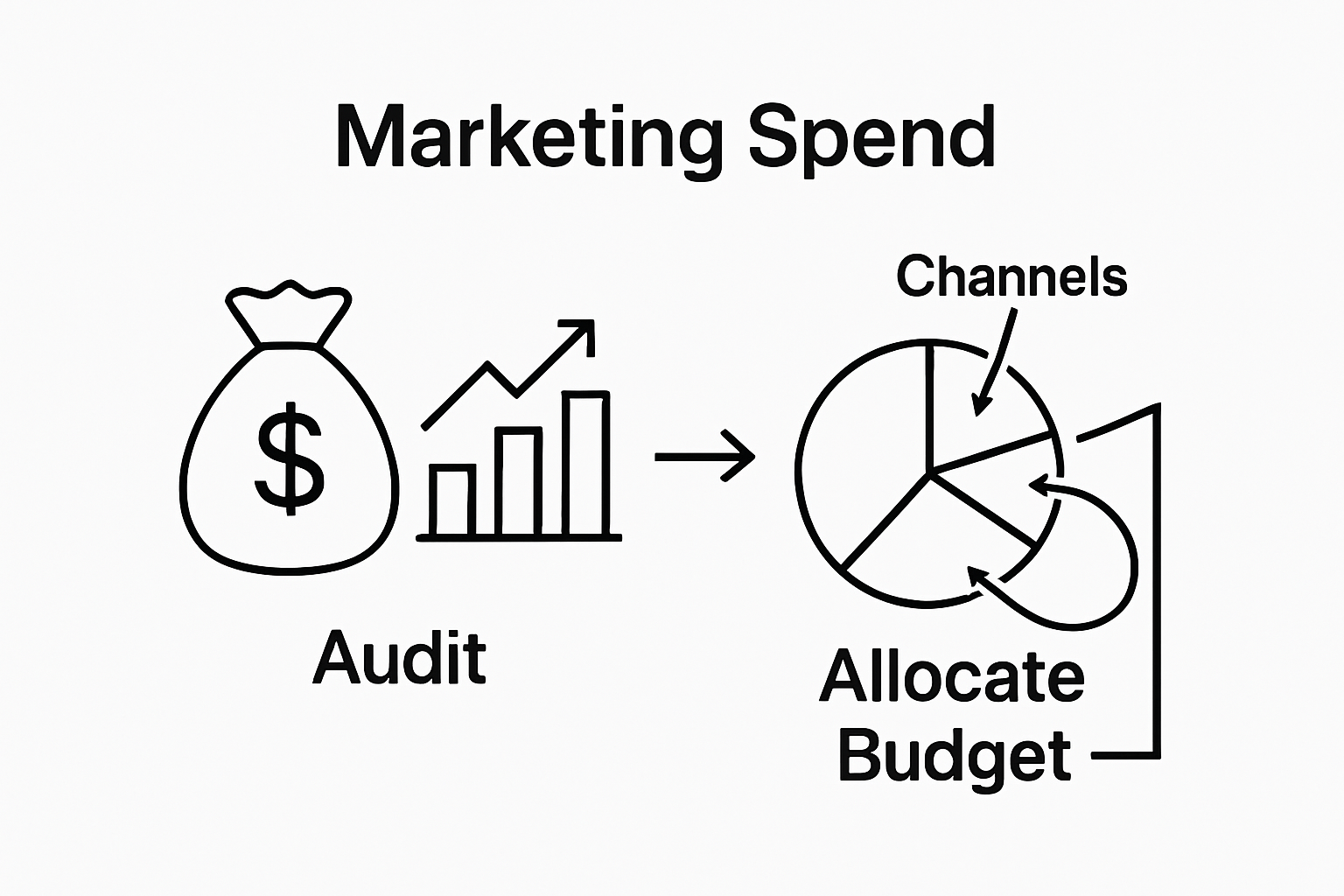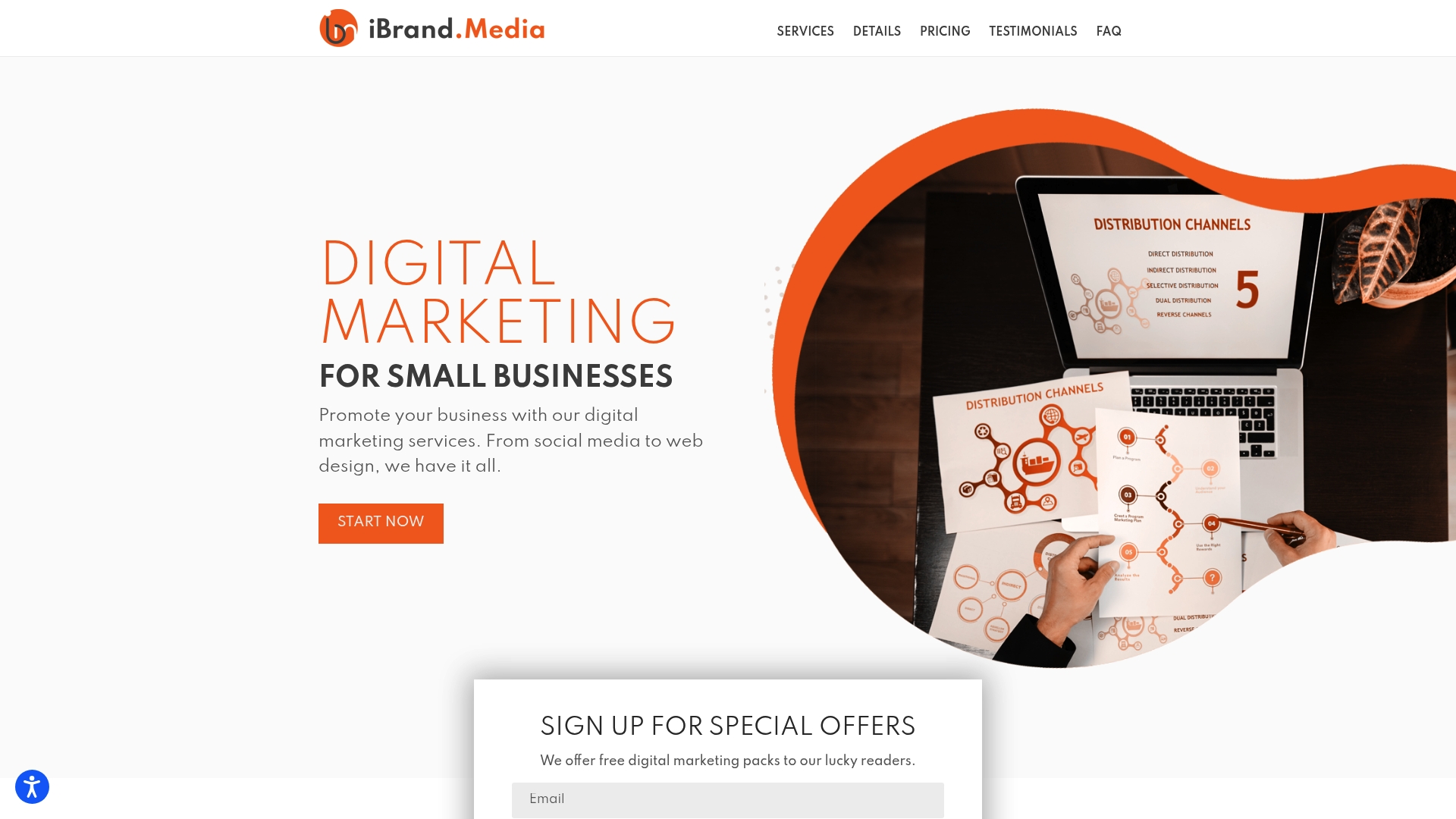Finding the right marketing channels can make or break your business goals. Small businesses allocate between 5% to 10% of their revenue to marketing, yet nearly half end up investing in platforms that do not actually reach their ideal customers. Surprising, right? Most people spend time guessing which channels work, but the real winners treat channel selection as a scientific process built on ongoing testing and hard data.
Table of Contents
- Step 1: Identify Your Target Audience And Their Preferences
- Step 2: Evaluate Available Marketing Channels For Your Business
- Step 3: Analyze Your Budget And Resource Allocation
- Step 4: Test Selected Channels For Effectiveness
- Step 5: Measure Results And Optimize Channel Selection
Quick Summary
| Key Point | Explanation |
|---|---|
| 1. Understand your target audience deeply | Create detailed buyer personas to reveal motivations and preferences beyond basic demographics. |
| 2. Evaluate channels for cost-effectiveness | Assess potential reach and engagement against your budget when selecting marketing platforms. |
| 3. Test channels with controlled experiments | Implement small-scale tests to gather data on marketing effectiveness before fully committing resources. |
| 4. Measure performance with key indicators | Establish a performance dashboard to analyze metrics like customer acquisition cost and revenue generation. |
| 5. Optimize based on data insights | Regularly review and adjust marketing strategies based on performance data to enhance growth. |
Step 1: Identify Your Target Audience and Their Preferences
Successful marketing begins with understanding precisely who you want to reach. Choosing marketing channels starts with a deep, nuanced comprehension of your potential customers. This critical first step transforms generic marketing attempts into targeted, resonant communication strategies.
Begin by creating detailed customer personas that go beyond basic demographics. Instead of simply noting age ranges or income levels, dive into psychological profiles that reveal motivations, challenges, and communication preferences. What keeps your potential customers up at night? What solutions are they desperately seeking? Comprehensive audience research reveals these crucial insights.
Utilize multiple research methods to build comprehensive audience profiles. Audience research techniques include:
- Conducting online surveys with existing customers
- Analyzing website and social media analytics
- Interviewing current clients about their needs and preferences
- Reviewing competitor audience engagement strategies
Once you have gathered detailed audience insights, map out their digital behavior. Understand which platforms they frequent, what content they consume, and how they make purchasing decisions. According to Nielsen Norman Group, effective personas should include not just statistical data, but narrative elements that humanize your target market.
Pay special attention to communication preferences. Some audiences prefer video content, while others might engage more deeply with long-form written material. Younger demographics might gravitate toward social media platforms, whereas professional audiences might spend more time on LinkedIn or industry-specific forums.
Verification comes through testing and refinement. Create preliminary marketing messages targeting your defined audience personas and measure engagement rates. Low response rates indicate a need to refine your understanding. High engagement confirms you have accurately captured your audience’s essence.
Remember that audience identification is not a one-time activity but an ongoing process. Markets evolve, consumer behaviors shift, and your marketing channels must adapt accordingly. Regularly revisit and update your audience personas to maintain marketing relevance and effectiveness.
Step 2: Evaluate Available Marketing Channels for Your Business
After identifying your target audience, the next crucial phase in choosing marketing channels involves systematically evaluating which platforms will most effectively reach and engage your potential customers. This step requires a strategic approach that balances potential reach, cost-effectiveness, and alignment with your specific business goals.
Start by categorizing marketing channels into digital and traditional mediums. Digital channels include social media platforms, email marketing, search engine advertising, content marketing, and website optimization. Traditional channels encompass print advertising, direct mail, television and radio spots, billboards, and local event sponsorships. Each channel carries unique strengths and limitations that must be carefully assessed against your audience research from the previous step.
Critical evaluation metrics should include potential audience reach, cost per acquisition, engagement rates, and conversion potential. For digital platforms, tools like Google Analytics, social media insights, and email marketing platforms provide granular performance data. According to Bayesian marketing attribution research, understanding both direct and interactive channel effects is essential for making informed marketing decisions.
Consider your business type and industry when evaluating channels. Service-based businesses might find LinkedIn or targeted Facebook ads more effective, while product-based businesses could benefit from visually driven platforms like Instagram or Pinterest. Local businesses often see significant returns from geotargeted digital advertising and community-focused marketing strategies.
Financial constraints play a significant role in channel selection. Budget-conscious businesses should prioritize channels offering the highest return on investment. This might mean focusing on low-cost, high-impact digital marketing approaches like:
- Search engine optimization (SEO)
- Content marketing through blogs and social media
- Email marketing campaigns
- Targeted social media advertising
Verification of your channel evaluation comes through setting clear, measurable goals for each platform. Track key performance indicators like website traffic, engagement rates, lead generation, and ultimately, conversion and sales. If a channel consistently underperforms across multiple measurement periods, it may be time to reallocate resources.
Remember that our guide on developing a digital marketing plan can provide additional insights into strategic channel selection. Flexibility remains crucial – be prepared to adjust your marketing channel mix as you gather more data and your business evolves.
To help you compare the advantages and limitations of different channels, here is a table summarizing digital and traditional marketing options, their strengths, limitations, and typical business fit.
| Marketing Channel Type | Examples | Strengths | Limitations | Typical Business Fit |
|---|---|---|---|---|
| Digital | Social media, SEO, email, content, PPC | High reach, detailed analytics, flexible budget | Requires ongoing management, can be complex | Startups, direct-to-consumer, online |
| Traditional | Print ads, radio, TV, billboards, events | Local targeting, predictable reach, trust factor | Higher upfront cost, less trackable | Local services, established brands |
| Geotargeted Digital | Local SEO, Google Ads, community social | Precise targeting, cost-efficient for local reach | Limited to local audience | Brick-and-mortar, local services |
| Visual Platforms | Instagram, Pinterest | Strong for visuals, product discovery | Less effective for B2B, fewer direct leads | E-commerce, lifestyle brands |
| Professional Networks | LinkedIn, industry-specific forums | B2B reach, authority building | Lower consumer engagement | Service providers, consultants |
Step 3: Analyze Your Budget and Resource Allocation
Choosing marketing channels requires a strategic financial approach that balances potential impact with realistic budget constraints. This step transforms your marketing vision from theoretical potential into actionable financial planning, ensuring every dollar spent delivers maximum strategic value.
Begin by conducting a comprehensive audit of your current marketing expenditures.
 Examine historical spending patterns, identifying which previous investments generated tangible returns and which represented underperforming expenses. Realistic budget allocation means understanding not just monetary resources, but also the time and personnel required to execute marketing strategies effectively.
Examine historical spending patterns, identifying which previous investments generated tangible returns and which represented underperforming expenses. Realistic budget allocation means understanding not just monetary resources, but also the time and personnel required to execute marketing strategies effectively.
Calculate your total marketing budget as a percentage of your overall business revenue. Small businesses typically allocate between 5% to 10% of total revenue toward marketing efforts, though this can vary significantly by industry and growth stage. Divide this budget strategically across different marketing channels based on their projected return on investment and alignment with your target audience research.
Consider both direct financial costs and indirect resource investments. Digital marketing channels often require less upfront capital but demand consistent content creation, platform management, and analytical tracking. Traditional marketing methods might have higher initial expenses but potentially offer more predictable reach in specific local markets.
Technology and automation can help optimize your marketing budget allocation. Free and low-cost tools can significantly reduce implementation expenses:
Below is a table summarizing essential free and low-cost marketing tools mentioned in the article, along with their primary use cases and benefits for small businesses.
| Tool | Main Purpose | Benefit |
|---|---|---|
| Google Analytics | Performance tracking | Monitor website and campaign effectiveness |
| Canva | Graphic design | Create engaging visuals affordably |
| Mailchimp | Email marketing | Automate email campaigns, easy management |
| Hootsuite | Social media management | Schedule posts and monitor engagement |
- Google Analytics for performance tracking
- Canva for graphic design
- Mailchimp for email marketing
- Hootsuite for social media management
Develop a flexible budget that allows for rapid reallocation. Marketing landscapes change quickly, and your financial strategy should accommodate swift pivots based on real-time performance data. Set clear key performance indicators for each marketing channel, establishing specific thresholds that trigger budget reallocation or strategy adjustments.
If you’re feeling overwhelmed by the complexity of marketing budgeting, our guide on choosing a marketing agency can provide additional strategic insights. Verification of successful budget allocation comes through consistent monitoring of customer acquisition costs, conversion rates, and overall marketing efficiency.
Remember that budget allocation is not a one-time event but an ongoing process of strategic refinement. Regularly review and adjust your marketing investments to ensure they continue driving meaningful business growth.
Step 4: Test Selected Channels for Effectiveness
Choosing marketing channels reaches its most critical phase during testing, where theoretical strategies transform into measurable performance insights. This step involves systematically evaluating each selected marketing channel to determine its actual effectiveness for your specific business context.
Begin with a controlled, incremental testing approach. Instead of committing substantial resources across multiple channels simultaneously, start with small-scale experiments that minimize financial risk while generating meaningful data. Create distinct, trackable campaigns for each channel, ensuring you can isolate and measure individual platform performance.
Implement A/B testing methodologies to compare different marketing approaches within the same channel. This might involve testing variations in ad copy, visual design, targeting parameters, or call-to-action messaging. According to research on marketing channel testing strategies, the key is balancing the opportunity cost of testing with potential gains from discovering optimal marketing treatments.
Key performance metrics should extend beyond simple engagement numbers. Look for indicators that directly connect to business objectives such as:
- Customer acquisition cost
- Conversion rates
- Total revenue generated
- Return on marketing investment
- Lead quality and qualification rates
Utilize robust analytics tools to track these metrics comprehensively. Google Analytics, platform-specific insights, and specialized marketing attribution software can provide granular data about how different channels contribute to your business goals. Pay special attention to customer journey tracking, understanding not just whether a channel generates interest, but how effectively it moves potential customers through your sales funnel.
Establish clear testing duration and performance thresholds before launching experiments. Decide in advance what constitutes a successful or underperforming channel. Typically, a testing period of 30 to 90 days provides sufficient data to make informed decisions, though this can vary based on your business model and sales cycle.
Remember that testing is an ongoing process. Marketing channels evolve rapidly, and what works today might become less effective tomorrow. Our guide on developing a digital marketing plan offers additional strategies for maintaining marketing flexibility.
Verification of successful channel testing comes through establishing a clear decision-making framework. If a marketing channel consistently fails to meet predefined performance benchmarks across multiple test cycles, be prepared to reallocate resources to more promising platforms.
 Successful testing is not about finding perfect channels, but continuously refining your marketing approach to maximize business growth.
Successful testing is not about finding perfect channels, but continuously refining your marketing approach to maximize business growth.
Step 5: Measure Results and Optimize Channel Selection
Choosing marketing channels reaches its most critical moment during measurement and optimization, transforming raw data into strategic insights that drive business growth. This step involves systematically analyzing your marketing performance, identifying strengths and weaknesses, and making data-driven decisions to refine your approach.
Begin by establishing a comprehensive performance dashboard that aggregates metrics from all tested marketing channels. This holistic view allows you to compare performance across platforms, understanding not just individual channel effectiveness, but their interconnected impact on your overall marketing strategy. According to research on causal marketing mix modeling, advanced measurement techniques can reveal complex interactions between different marketing approaches.
Key performance indicators should extend beyond surface-level metrics, diving deep into meaningful business outcomes. Look for indicators that directly connect marketing efforts to tangible business results:
- Customer acquisition cost
- Lifetime customer value
- Conversion rates
- Revenue generated per channel
- Return on marketing investment
Implement a systematic optimization approach that goes beyond simple performance tracking. Create a quarterly review process where you critically evaluate each marketing channel’s contribution to your business goals. This means looking not just at raw numbers, but understanding the qualitative aspects of customer engagement and brand perception.
Utilize advanced analytics tools that offer granular insights into customer journey and channel performance. Google Analytics, specialized marketing attribution software, and platform-specific insights can provide deep understanding of how different channels interact and influence potential customers. Pay special attention to multi-touch attribution models that reveal the complex paths customers take before making a purchase.
Our guide on best online advertising channels can provide additional context for interpreting your performance data. The optimization process requires both analytical rigor and creative thinking. Be prepared to make bold shifts in your marketing strategy when data clearly indicates a need for change.
Verification of successful optimization comes through establishing a continuous improvement framework. Set clear benchmarks for each marketing channel, creating specific thresholds that trigger reevaluation or resource reallocation. Remember that marketing is an evolving landscape – what works today might require adjustment tomorrow. The most successful businesses maintain a flexible, data-driven approach to marketing channel selection, constantly refining their strategy to maximize growth and efficiency.
Supercharge Your Channel Strategy with Results-Driven Marketing
Are you struggling to find which marketing channels truly deliver growth? After following every step from audience research to performance testing, it becomes clear how many moving parts there are. Small business owners often feel frustrated by wasted time and money, especially when channels underperform or your message never reaches the right people. The article points to the challenge of aligning your budget and resources with the channels that move the needle—while constantly needing up-to-date data and flexibility to adapt quickly.
Let us help turn uncertainty into opportunity. At ibrand.media, you gain access to proven tools and hands-on digital marketing experts who guide you through every phase, from real-time performance tracking to affordable, mobile-friendly campaigns tailored to your audience insights.

Stop guessing and start growing. Visit ibrand.media to request your custom digital marketing plan today, or discover how our small business solutions for SEO optimization and social media management can amplify your chosen channels while keeping your budget on track. Turn your marketing mix into real results now.
Frequently Asked Questions
What are the first steps in choosing marketing channels?
The initial steps include identifying your target audience and their preferences, which involves creating detailed customer personas and conducting comprehensive audience research to understand their behaviors and needs.
How can I evaluate which marketing channels are right for my business?
You can evaluate marketing channels by categorizing them into digital and traditional mediums, considering metrics such as potential audience reach, cost per acquisition, and engagement rates. Align these with your audience research for effective selection.
What should I consider when analyzing my marketing budget?
Begin with an audit of current expenditures, establish your total marketing budget as a percentage of revenue, and strategically allocate funds across channels based on projected returns. Don’t forget to factor in both direct and indirect costs related to each channel.
How do I measure the effectiveness of selected marketing channels?
To measure effectiveness, utilize a comprehensive performance dashboard to track key performance indicators such as customer acquisition cost and conversion rates. Implement systematic reviews, and be ready to optimize and adjust channels based on the data you gather.
Recommended
- Balancing Online and Offline Marketing for Small Businesses 2025 | Ibrandmedia
- Digital Marketing for Retailers: Proven Strategies for 2025 | Ibrandmedia
- Developing a Digital Marketing Plan: A 2025 Guide for Small Businesses | Ibrandmedia
- Choosing a Marketing Agency in 2025: A Small Business Guide | Ibrandmedia

Recent Comments